 Open Access
Open Access
ARTICLE
Prediction of Apple Fruit Quality by Soil Nutrient Content and Artificial Neural Network
1 College of Horticulture, Nanjing Agricultural University, Nanjing, China
2 College of Agriculture, Nanjing Agricultural University, Nanjing, China
* Corresponding Author: Sanhong Wang. Email:
(This article belongs to the Special Issue: Integrating Agronomy and Plant Physiology for Improving Crop Production)
Phyton-International Journal of Experimental Botany 2023, 92(1), 193-208. https://doi.org/10.32604/phyton.2022.023078
Received 08 April 2022; Accepted 25 May 2022; Issue published 06 September 2022
Abstract
The effect of soil nutrient content on fruit yield and fruit quality is very important. To explore the effect of soil nutrients on apple quality we investigated 200 fruit samples from 40 orchards in Feng County, Jiangsu Province. Soil mineral elements and fruit quality were measured. The effect of soil nutrient content on fruit quality was analyzed by artificial neural network (ANN) model. The results showed that the prediction accuracy was highest (R2 = 0.851, 0.847, 0.885, 0.678 and 0.746) in mass per fruit (MPF), hardness (HB), soluble solids concentrations (SSC), titratable acid concentration (TA) and solid-acid ratio (SSC/TA), respectively. The sensitivity analysis of the prediction model showed that soil available P, K, Ca and Mg contents had the greatest impact on the quality of apple fruit. Response surface method (RSM) was performed to determine the optimum range of the available P, K, Ca, and Mg contents in orchards In Feng County, which were 10∼20 mg⋅kg−1, 170∼200 mg⋅kg−1, 1000∼1500 mg⋅kg−1, and 80∼200 mg⋅kg−1, respectively. The research also concluded that improving the content of available P and available Ca in orchard soil was crucial to improve apple fruit quality in Feng County, Jiangsu Province.Keywords
Apple (Malus domestica) is a deciduous tree of the genus apple in the Rosaceae, native to Eastern and Southeastern Europe. Due to its strong climatic adaptability, high nutritional value, and storage and transportation resistance apple has become one of the world’s largest fruits in demand [1]. China is the world’s largest apple producer and consumer; cultivation area and yield are ranked first in the world [2].
Soil is the basis for the survival of fruit trees, and the nutrients required for the growth and development of fruit trees are mainly obtained from the soil by roots. Therefore, the nutrient content in the soil and the proportional relationship between various elements will directly affect the yield and fruit quality of fruit trees. At domestic and international predecessors have done a lot of researches on the relationship between soil nutrient content and fruit quality in orchard. Potassium content in orchard soil was positively correlated with soluble solids concentrations (SSC) in ‘Valencia’ orange fruit [3]. Correlation analysis between soil nutrients and fruit quality in kiwifruit orchard showed that the hardness (HB) of kiwifruit was mainly affected by available potassium and exchangeable calcium; soluble solids were affected by available potassium, and titratable acid (TA) was mainly affected by organic matter [4]. The TA content in apple orchard was significantly correlated with soil P/K content, and SSC was significantly correlated with soil Ca/K content [5]. At present, the research on fruit quality and soil minerals mainly adopts multiple linear regression, but the regression theory is often faced with the problem of recollinearity when dealing with practical problems [6]. Improper treatment will lead to the instability of the regression coefficient, and the values and symbols of the regression coefficient will be greatly different from the actual problems. In order to solve this problem, in recent years, agricultural scientists have introduced artificial intelligence (AI) model into agricultural production.
Artificial neural networks (ANN) are also called connection models, which are similar to human brain synaptic connection structures and information processing [7]. Its main components are input layer, hidden layer and output layer [8]. The essence of ANN is to convert input into output and form a mathematical mapping relationship, which is determined by the structure of the network, and the network structure is designed and trained according to specific problems [9]. The key advantage of ANN model is that it does not need to specify appropriate fitting functions and has complete computational ability to estimate almost all types of nonlinear functions [10]. ANN has been proved to be a reliable and accurate prediction tool and has been widely used in the prediction of economic crops [11].
In the present study, we evaluated the correlation between different input variables obtained by different ANN models and Fuji apple fruit quality, explored the effect of soil nutrient factors on Fuji apple fruit quality, and quantified the soil nutrient factors that significantly affected fruit quality, providing a theoretical basis for accurate fertilization in orchards.
200 apple orchard plots were selected in Feng County of Jiangsu Province, China (Fig. 1). The apple material was ‘Red Fuji’, with a rootstock of M9T337, age of 7∼8 years, and a row spacing of 4 m × 5 m. Orchard fertilization is mainly organic fertilizer in autumn, about 1.5∼2.0 tons per mu (666.67 m2). At sprouting stage, about 140 kg quick-acting nitrogen fertilizer was applied per mu (666.67 m2), and about 40 kg⋅mu−1 potassium fertilizer and 30 kg⋅mu−1 phosphorus fertilizer were applied at fruit enlargement stage. In each sample plot, 5 trees were randomly selected, and the sampling points were located near the vertical drip line of tree crowns in the east, south, west and north directions of each tree, respectively. Soil samples in the 0∼20 cm soil layer were collected, and the soil samples of each tree were mixed evenly. At the same time, apple fruits were collected when they were commercially mature in late October of 2020 and 2021. Four fruits were taken from the four directions of the soil sampling tree, and 20 fresh fruits were taken from each orchard as experimental materials.
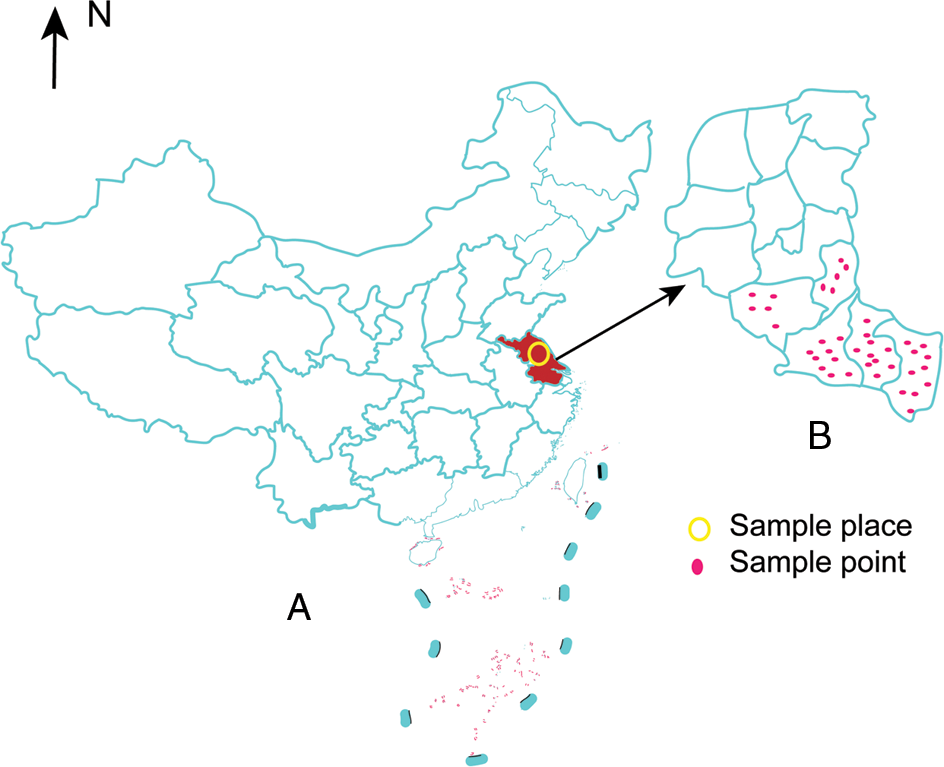
Figure 1: Sampling place and distribution of sampling points. A: the map of China; B: the map of Jiangsu Province
Note: According to the different orchard planting area in different locations, select the appropriate number of sampling points.
The soil samples were placed in a cool and ventilated place for natural drying. The soil after natural drying was passed through a 60-mesh sieve and stored for the determination of soil physicochemical properties. Determination of fruit quality and soil nutrients as shown in Table 1.

To generate more accurate results, the SPSS 20.0 software was used for statistical analysis of orchard soil nutrients and fruit quality data, and used R. 4.03 software was used for simple Pearson correlation coefficient analysis.
In the establishment of the ANN model, we used the multi-layer perceptron (MLP) structure (Fig. 2). The values of the soil pH and nutrient element content were used as the input layer, and the fruit quality indexes of the apple as output layer, respectively, for establishing and testing ANN. The ratios of training set data, validation set data and test set data were 70%, 15% and 15%, respectively. In order to improve the speed and accuracy of the training model, the input data and output data are normalized in the range of 0∼1. The formula is as follows [14]:
where Q is the original measurement data, Qn is the normalized value of the original measurement data, and Qmax and Qmin are the maximum and minimum values of variables.
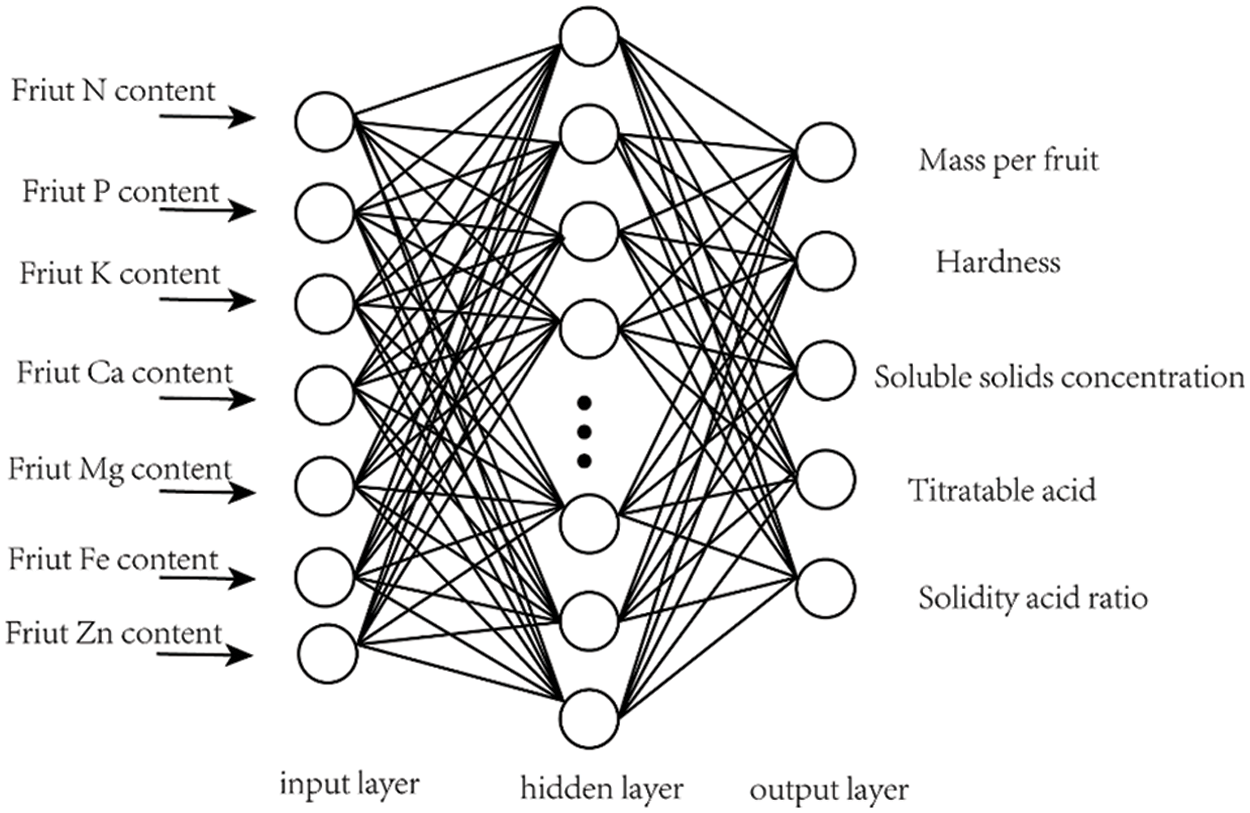
Figure 2: Multi-layer perceptron model structure
The learning rate of the model lr = 0.01, the learning accuracy goal = 0.0001, the momentum = 0.9, the maximum training epochs = 1000, and the number of hidden layers = 1 [15]. The number of neurons in the hidden layer adopted the trial-and-error method, and the number of hidden layers was set to 1∼15, with 100 repetitions. Tagsig transfer function was used between the input layer and the hidden layer, and the logsig transfer function was used between the hidden layer and the output layer. Essentially, the most important and highly correlated input variables may bring better prediction results [16]. We established the prediction model of fruit quality by soil nutrient factors through MATLAB software (2017 edition). Pearson coefficient of determination (R2), root mean square error (RMSE) and mean absolute error (MAE) were used to evaluate the performance of the prediction model [17,18].
Log-sigmoid function
Tangent-sigmoid function:
where n is the number of input or output data, a is a constant, and e is a natural logarithm. Wi is the original measurement value, Mi is the predicted value of the established model, and the bar chart is the average value of the relevant variables.
3.1 Basic Overview of Orchard Soil pH, Nutrients and Fruit Quality
Apple fruit quality indicators and soil pH and nutrient contents are shown in Tables 2 and 3, respectively. The average of apple MPF was 305.50 g, average of HB was 7.21 kg⋅cm−2, and the average content of SSC, TA, SSC/TA were 12.21%, 0.34%, 37.07, respectively. The maximum values were 416.95 g, 8.96 kg⋅cm−2, 17.13%, 0.54%, and 60.17, respectively; the minimum values were 187.23 g, 5.18 kg⋅cm−2, 8.10%, 0.18% and 21.21, respectively (Table 2). The mean soil organic matter content and soil total N in orchards were 12.82 and 1.85 g⋅kg−1; the mean values of soil available P, available K, available Ca, available Mg, available Fe and available Zn were 17.06, 159.26, 996.06, 136.28, 13.30 and 3.77 mg⋅kg−1, respectively (Table 3), and the mean values of soil pH was 8.2.


3.2 Correlation Analysis of Soil pH, Nutrient and Fruit Quality in Orchard
Soil is the basis for the survival of fruit trees. The correlation analysis between fruit quality and soil factors is shown in Fig. 3. In terms of soil nutrients, soil pH was negatively correlated with all soil factors, and was significantly negatively correlated with soil organic matter, available P, available Ca, available Fe and available Zn. On the contrary, soil organic matter had a positive correlation with most soil factors, among which there was a very significant positive correlation with soil total N and available P, and a significant positive correlation with available Ca and K; soil available Ca was significantly positively correlated with available P and Mg contents. The correlation analysis between soil factors and fruit quality demonstrated that soil organic matter was positively correlated with MPF, SSC and SSC/TA. Soil pH was significantly negatively correlated with HB, SSC and SSC/TA, and significantly positively correlated with TA. Soil available Ca was significantly positively correlated with HB, SSC and TA; soil total N was significantly negatively correlated with HB. The correlation analysis between soil factors and fruit quality demonstrated that soil organic matter was positively correlated with MPF, SSC and SSC/TA. Soil pH was significantly negatively correlated with HB, SSC and SSC/TA, and significantly positively correlated with TA. Soil available Ca was significantly positively correlated with HB, SSC and TA; soil total N was significantly negatively correlated with HB.
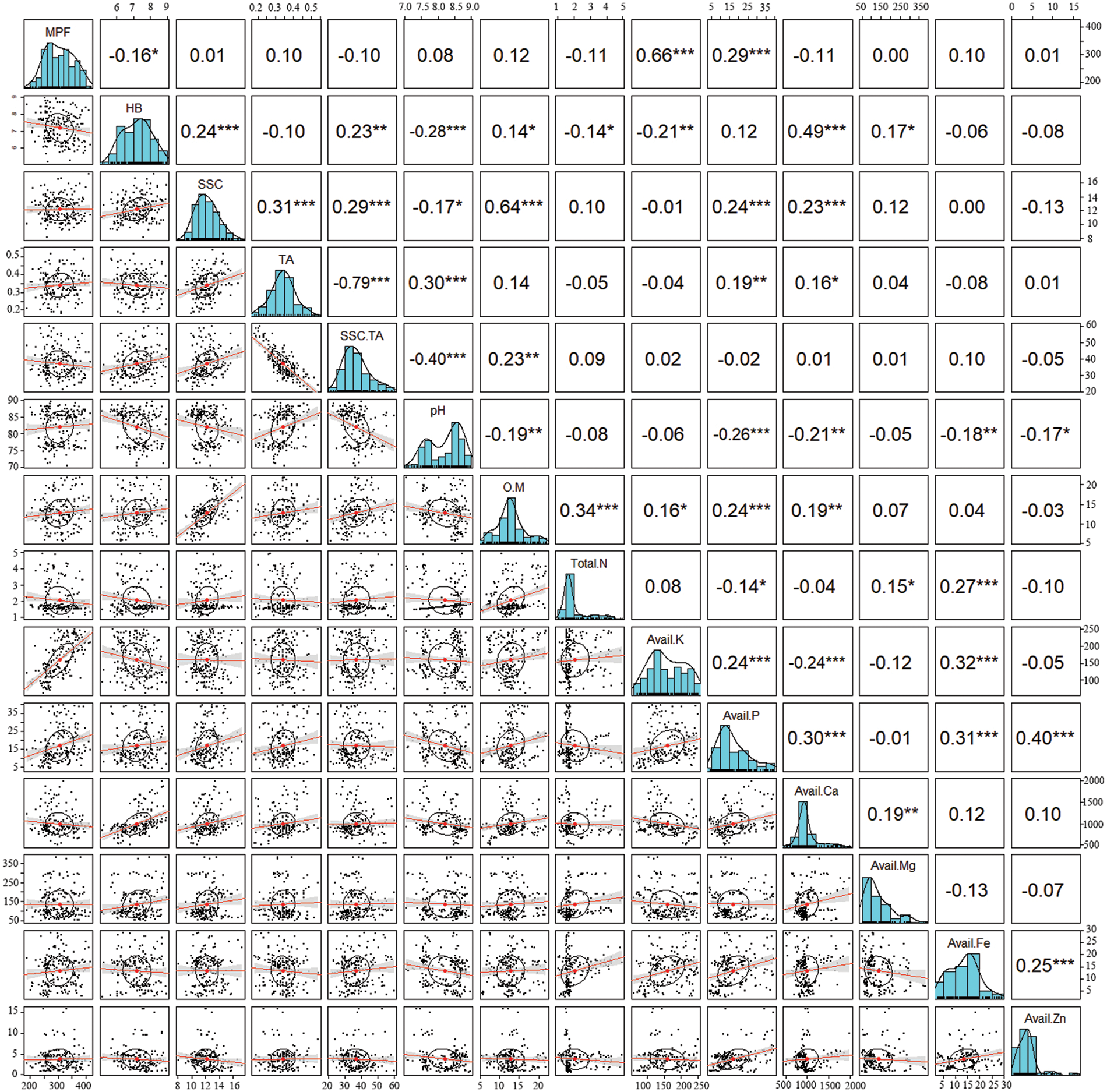
Figure 3: Pearson correlation coefficient of soil factors and fruit quality factors in ANN model
Note: The distribution of each variable in the figure is shown in the diagonal; the bivariate scatter diagram with regression line is displayed in the left lower part of the diagonal. The shadow section in the diagram is a confidence interval. Display the correlation coefficient in the upper right corner of the diagonal plus the star sign display the aboriginal level, each saliency level is associated with a sign: P value (“***”: 0.001, “**”: 0.01, “*”: 0.05). MPF: Mass per fruit; HB: Hardness; SSC: Soluble solids concentrations; TA: Titratable acid concentration; SSC/TA: Solidity acid ratio.
3.3 Establishment of an Artificial Neural Network Model
In order to obtain an effective model for predicting fruit quality, we tested the performance of ANN in predicting apple fruit quality under different input layers (Table 4). The results showed that when the input layer was 9, the performance of ANN in predicting apple fruit quality was the best. Subsequently, we used different training functions to evaluate the performance of the established ANN model. The results are shown in Table 5. When LM was used as the training function, the prediction accuracy of single fruit weight (R2 = 0.851), hardness (R2 = 0.847), SSC (R2 = 0.885), TA (R2 = 0.678) and SSC/TA (R2 = 0.746) reached the highest (Table 5). In order to better detect the ability of the established ANN model to predict apple fruit quality, we compared the distribution models of predicted and observed values of single fruit weight (Fig. 4A), hardness (Fig. 4B), SSC (Fig. 4C), TA (Fig. 4D) and SSC/TA (Fig. 4E), respectively. The results showed that their predicted and observed values had similar distribution patterns, indicating that the established ANN model could accurately predict apple fruit quality.


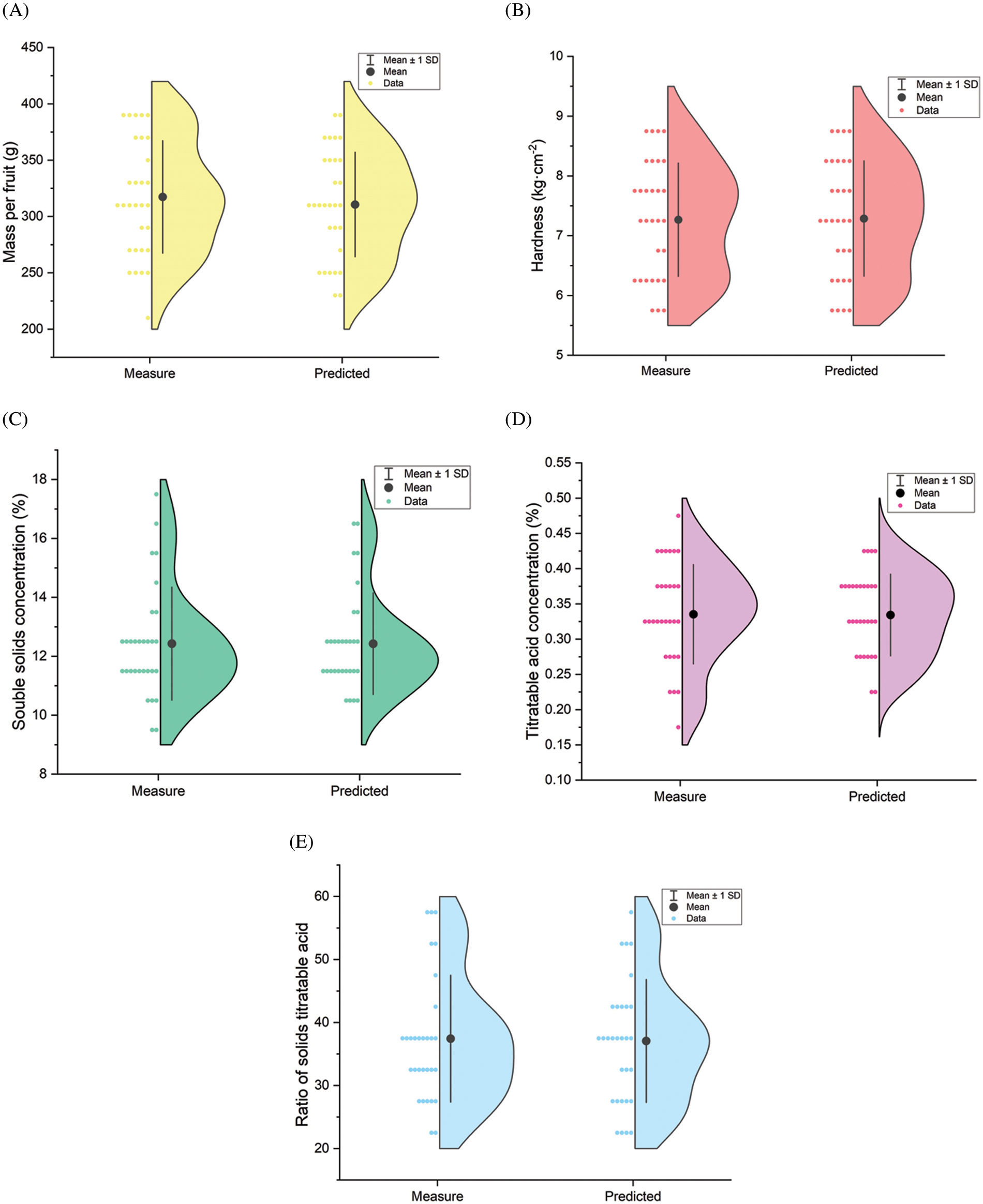
Figure 4: The ANN model of fruit quality. A: Violin plot and scatter plot of predicted and measured mass per fruit values. B: Violin plot and scatter plot of predicted and measured hardness values. C: Violin plot and scatter plot of predicted and measured soluble solids concentrations values. D: Violin plot and scatter plot of predicted and measured titratable acid values. E: Violin plot and scatter plot of predicted and measured solidity acid ratio values
3.4 Sensitivity Analysis of Soil Factors to Fuji Apple Fruit Quality
Sensitivity analysis is an analysis method to reveal the importance of individual variables [23]. In order to calculate the individual contribution of each soil factor input to the prediction of apple fruit quality, we conducted a sensitivity test on the established model. In the sensitivity analysis, we can use the RMSE value to express the influence of soil factors on apple fruit quality factors. The higher the RMSE value, the higher the importance of soil factors to fruit quality factors [24]. The MPF of Fuji apple was mainly affected by the contents of soil available K (RMSE = 0.641), available Ca (RMSE = 0.565) and available Mg (RMSE = 0.483) (Fig. 5A). The fruit hardness was mainly affected by soil total N (RMSE = 0.710), available Mg (RMSE = 0.737) and available Ca (RMSE = 0.694) (Fig. 7B). Soil organic matter (RMSE = 0.4334), available P (RMSE = 0.449) and available Zn (RMSE = 0.439) had significant effects on fruit SSC (Fig. 5C). TA was mainly affected by soil available P (RMSE = 0.594), soil total N (RMSE = 0.522) and available Zn (RMSE = 0.513) (Fig. 5D). The SSC/TA was mainly affected by soil available Zn (RMSE = 0.656), soil available Mg (RMSE = 0.590) and soil available Ca (RMSE = 0.586) (Fig. 5E).
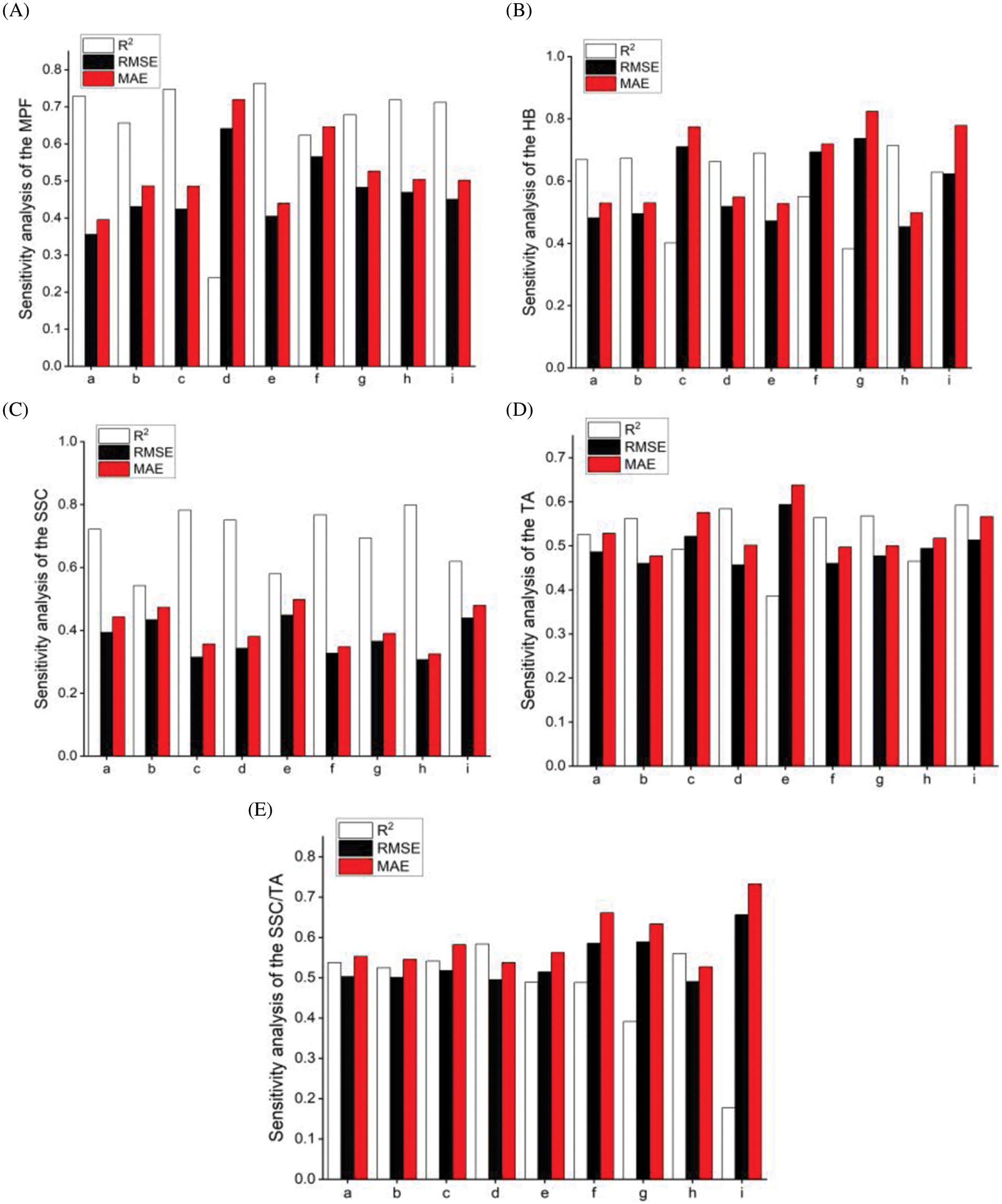
Figure 5: Sensitivity analysis of mass per fruit (A), hardness (B), soluble solid content (C), titratable acid content (D) and solid-acid ratio (E) of Fuji apple
Note: a: ANN without pH; b: ANN without O.M; c: ANN without N; d: ANN without K; e: ANN without P; f: ANN without Ca; g: ANN without Mg; h: ANN without Fe; i: ANN without Zn.
3.5 Response Surface Methodology (RSM) Analysis
In order to further explore the soil nutrient content for high-quality fruit quality, we drew a RSM of soil factors that significantly affected fruit quality screened out in the sensitivity analysis (Fig. 6). The effects of available K, available Mg content and available K, available Ca content on MPF are shown in Figs. 6A and 6B. The MPF reached its maximum when the available Mg content in orchard soil was 120∼200 mg⋅kg−1, the available Ca content was 1000∼1100 mg⋅kg−1, and the available K content was 170∼200 mg⋅kg−1. The effects of soil available Mg, total N content and available Mg, available Ca content on HB are shown in Figs. 6C and 6D. The HB reached its maximum when the available Mg content in orchard soil was 80∼200 mg⋅kg−1, the available Ca content was 1000∼1200 mg⋅kg−1, and the total N content was 1.5∼2.5 g⋅kg−1. The effects of available Zn, available P content, organic matter and available Zn content on SSC are shown in Figs. 6E and 6F. The SSC of fruit reached the maximum when the available P content in orchard soil was 10∼20 mg⋅kg−1, the available Zn content was 2.0∼4.0 mg⋅kg−1, and the organic matter content was 15∼18 mg⋅kg−1. The effects of soil available P, total N content and available P, available Zn content on TA are shown in Figs. 6G and 6H. A low TA content was obtained when the soil total N content was between 2.0∼2.5 g⋅kg−1, the available P content was 10∼17 mg⋅kg−1, and the available Zn content was 2.0∼4.0 mg⋅kg−1. The effects of available Zn, available Ca content and available Zn, available Mg content on SSC/TA are shown in Figs. 6I and 6J. The SSC/TA content was the highest. when the available Zn content was 2.5∼4.0 mg⋅kg−1, the available Mg content was 110∼130 mg⋅kg−1, and the available Ca content was 1300∼1500 mg⋅kg−1.
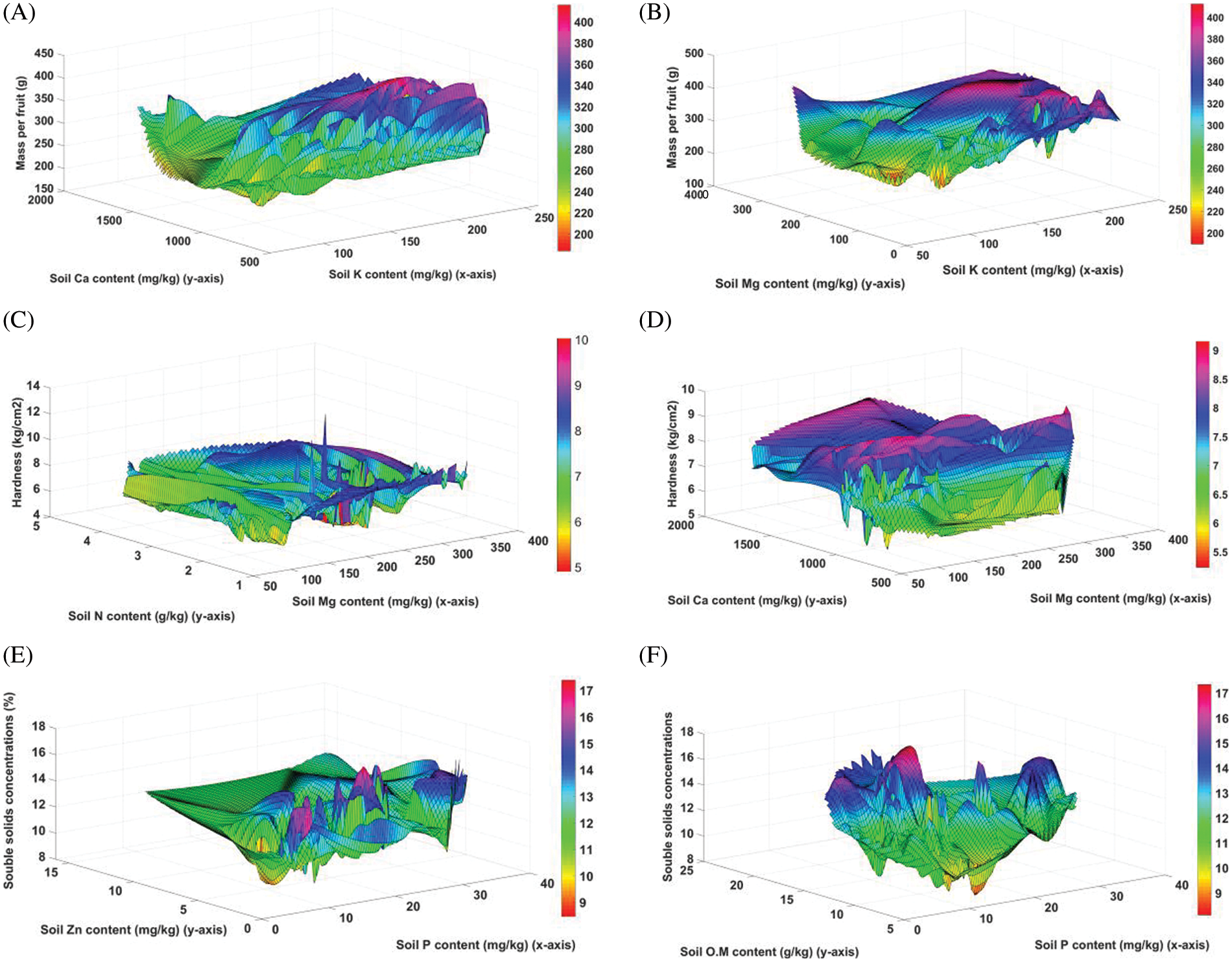
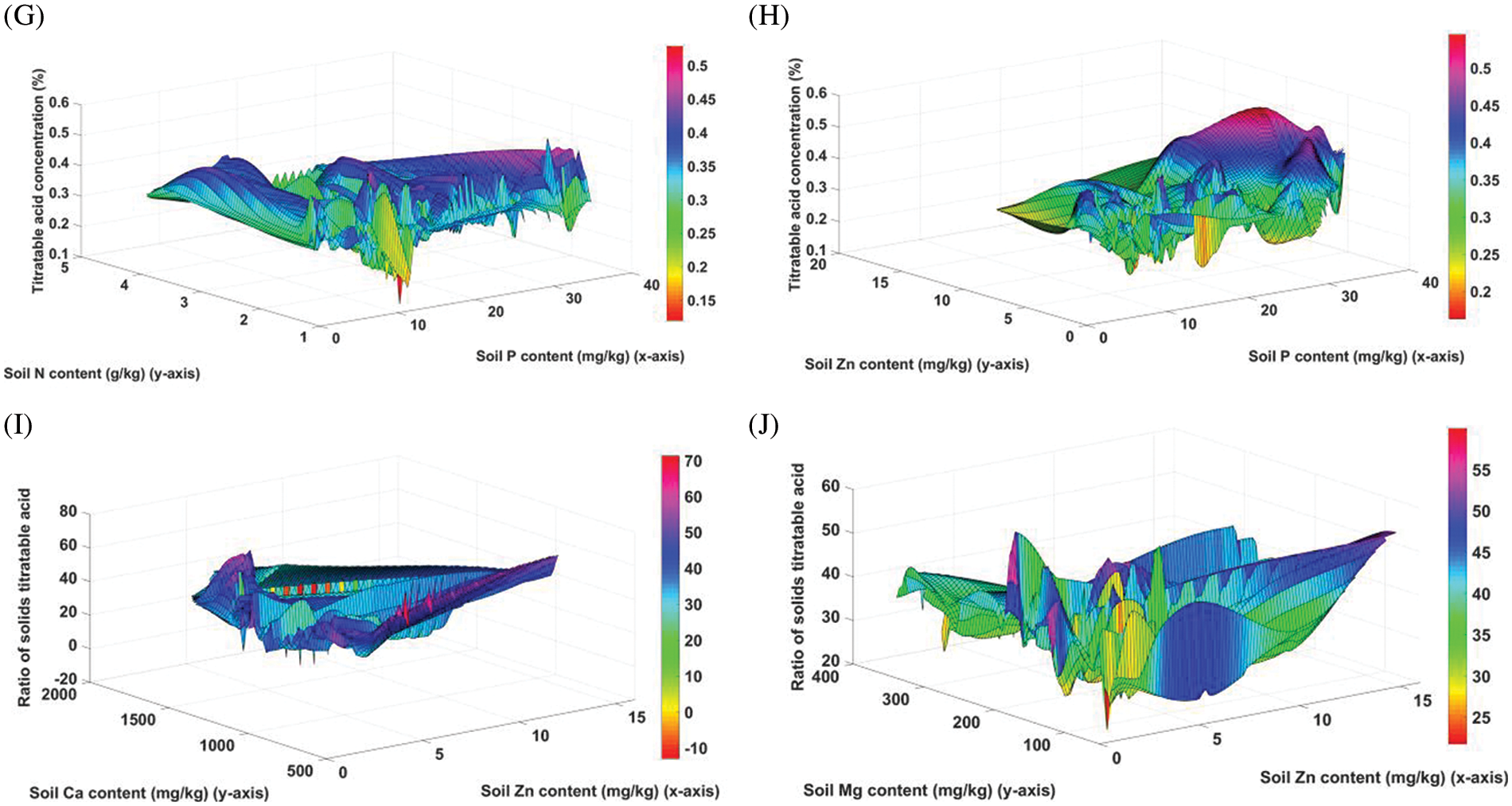
Figure 6: Response surface diagram of fruit quality factors and soil factors. A: Soil available K, available Ca content and MPF; B: Soil available K, available Mg content and MPF; C: Soil total N, available Mg content and HB; D: Soil available Ca, available Mg content and HB; E: Soil available Zn, available P content and SSC; F: Soil available Zn, organic matter content and SSC; G: Soil available P, Soil total N content and TA; H: Soil available P, Soil available Zn, content and TA; I: Soil available Zn, available Ca content and SSC/TA; J: Soil available Zn, available Mg content and SSC/TA
3.6 Analysis and Comparison of Soil Nutrient Content in Orchards
In order to better guide orchard soil management, the optimal range of soil nutrients obtained by response surface analysis was compared with that with the soil nutrient content of the 40 investigated orchards (Table 6). The study found that 80% of the orchard soil organic matter content was lower than 15 g⋅kg−1, 60% of the orchard soil total nitrogen content did not reach the nutrient optimization range, 57.5% of the orchard soil available potassium content was insufficient, and 70% of the orchard soil available calcium content was insufficient, which may be related to the investigation of the orchard soil pH. Therefore, improving soil organic matter, available potassium and available calcium contents and reducing soil pH were the key points of orchard soil management in Feng County, Jiangsu Province.

4.1 Construction and Evaluation of Artificial Neural Network Model
ANN is an operational model to simulate the human brain from the perspective of information processing [25]. ANN can learn complex relationships from a given input/output data mode and summarize the results, which is an appropriate technology to solve nonlinear and complex system modeling [10]. Based on the high accuracy of prediction data during training and testing, five reliable prediction models were obtained, which can accurately predict apple fruit quality indicators. When the topological structure of single fruit weight prediction model was 9:12:1, hardness topological structure was 9:4:1, SSC topological structure was 9:9:1, TA topological structure was 9:7:1 and SSC/TA topological structure was 9:11:1 (see LM Best Model: Table 6), and the prediction accuracy was the highest (see LM training function: Table 6, R2 = 0.851, 0.847, 0.885, 0.678 and 0.746). Niazian et al. [6] showed that the ANN model with a topological structure of 4:4:1 could more accurately predict the seed yield of Ajowan. Belouz et al. [26] showed that the ANN model with 12:34:1 topological structure was the best model for predicting tomato yield. We also found that the Levenberg-Marquardt training function predicted fruit quality more accurately. This was because LM was more suitable for training small and medium data sets [27].
4.2 Importance of Soil Mineral Nutrients to Fruit Quality
The relationship between soil nutrients and fruit quality is complex, and the effects of soil nutrients on different fruit quality factors are different. In the present study, soil available K, Mg, and Ca were consistently identified by ANN as the most important factors for MPF. Bennewitz et al. [28] showed that soil exchangeable K, Mg, and Ca contents were the main factors affecting the yield of ‘Jonagold’ apple, which was consistent with our results. K is considered a quality element and plays an active role in improving the quality of agricultural products [29]. Mg is a component of chlorophyll, which affects crop yield by affecting sink strength, sugar accumulation in source and sink organs, and phloem output of sucrose [30]. Ca is an important component of plant cell wall, which can promote epidermal cell division, thereby accelerating the growth of fruit epidermis and promoting fruit development [31]. In addition, soil available calcium is also the main factor affecting fruit firmness. This is because Ca2+ can combine with pectin in the cell wall to form calcium pectin, which increases the mechanical strength to maintain the stability of the cell wall structure [32]. In our research, soil available P was the main influencing factor of fruit SSC in apple. The result was similar with that of SSC in strawberry fruits which was positively correlated with P content in the soil [33]. P is a major component of important compounds in plants, which can promote the synthesis and accumulation of carbohydrates and improve fruit sugar content [34]. As for the relative contribution, available P, K, Ca and Mg contents in the soil greatly influenced fruit quality indexes of apple.
4.3 Optimization of Soil Nutrient Content for Apple Production
Soil is the basis for the survival of fruit trees. In daily orchard production and management, high or low soil nutrient content will directly affect the yield and fruit quality [35]. Therefore, scientific soil management schemes can be formulated according to the growth and development characteristics of fruit trees to achieve high quality and high yield on orchards. In this paper, ANN sensitivity analysis and RSM analysis were used to optimize the nutrient composition of apple orchard soils. Due to the differences in soil texture and management level of apple orchards in different regions, the optimization schemes of soil nutrients in apple orchards in different regions are also different. In the optimization scheme of this study, the soil organic matter content was 18 g⋅kg−1, and the soil total N content was 1.5∼2.5 g⋅kg−1, which were higher than those of Guo et al. [36], where the soil organic matter content was 12.41 g⋅kg−1, and the total N content was 0.8 g⋅kg−1. The optimization scheme emphasizes that the soil acidity and alkalinity of high-quality orchards are moderate, and the contents of soil organic matter, available P, K and Ca are appropriate, which is consistent with the high soil pH and insufficient contents of soil organic matter, available K and Ca in apple orchards in Feng County of Jiangsu Province. Therefore, improving the contents of soil organic matter, available K and available Ca in apple orchards is the focus of soil improvement in Feng County of Jiangsu Province in the future.
In this study, soil pH and nutrient factors were used as input variables, and fruit quality factors were used as output variables. Artificial neural network was used to predict fruit quality. The results showed that when Levenberg-Marquardt back propagation training function was used, MPF prediction model structure was 9:12:1, HB prediction model structure was 9:4:1, SSC prediction model structure was 9:9:1, TA prediction model structure was 9:7:1 and SSC/TA prediction model structure was 9:11:1, and the prediction accuracy was the highest (R2 = 0.851, 0.847, 0.885, 0.678 and 0.746). The results of sensitivity analysis showed that soil available P, K, Ca and Mg contents had the greatest impact on apple fruit quality. The suitable range of these mineral elements was determined by RSM. The available P content was 10∼20 mg⋅kg−1, the available K content was 170∼200 mg⋅kg−1, the available Ca content was 1000∼1500 mg⋅kg−1, and the available Mg content was 80∼200 mg⋅kg−1, which could significantly improve the quality of apple fruit.
Acknowledgement: The authors wish to thank the students involved in this project XQZ, HBZ and DT.
Authorship: MYY designed the experiments. MYY, XQZ, HBZ and DT performed the apple sample collection. MYY, XQZ and HBZ performed the experiments. MYY and SHW wrote and revised the manuscript. All authors read and approved the final manuscript.
Funding Statement: This work was supported by the National Key Research and Development Program of China (2019YFD1000103) and National Natural Science Foundation of China (31872076). This work was supported by the National Key Research and Development Program of China (2019YFD1000103) and National Natural Science Foundation of China (31872076). The funding body had no role in the design of the study; in the collection, analyses, or interpretation of data; in the writing of the manuscript, and in the decision to publish the results.
Conflicts of Interest: The authors declare that they have no conflicts of interest to report regarding the present study.
Reference
1. Boyer, J., Liu, R. H. (2004). Apple phytochemicals and their health benefits. Nutrition Journal, 3, 5. DOI 10.1186/1475-2891-3-5. [Google Scholar] [CrossRef]
2. Zhang, Q. Q., Shi, F. J., Abdullahi, N. M., Shao, L. Q., Huo, X. X. (2020). An empirical study on spatial-temporal dynamics and influencing factors of apple production in China. PLoS One, 15(10), e0240140. DOI 10.1371/journal.pone.0240140. [Google Scholar] [CrossRef]
3. Aular, J., Rengel, M., Montaño, M., Aular-Rodriguéz, J. (2010). Relationship between soil and leaf potassium content and ‘valencia’ orange fruit quality. Acta Horticulturae, 868, 401–404. DOI 10.17660/ActaHortic.2010.868.54. [Google Scholar] [CrossRef]
4. Chen, M. Y., Zhao, T. T., Peng, J., Zhang, P., Han, F. et al. (2021). Multivariate analysis of relationship between soil nutrients and fruit quality in ‘Donghong’ kiwifruit (Actinidia chinensis var. chinensis) orchards. Plant Science Journal, 39(2), 193–200. DOI 10.11913/PSJ.2095-0837.2021.20193. [Google Scholar] [CrossRef]
5. Wang, G. Y., Zhang, X. Z., Wang, Y., Xu, X. F., Han, Z. H. (2015). Key minerals influencing apple quality in Chinese orchard identified by nutritional diagnosis of leaf and soil analysis. Journal of Integrative Agriculture, 14(5), 864–874. DOI 10.1016/S2095-3119(14)60877-7. [Google Scholar] [CrossRef]
6. Niazian, M., Sadat-Noori, S. A., Abdipour, M. (2018). Modeling the seed yield of Ajowan (Trachyspermum ammi L.) using artificial neural network and multiple linear regression models. Industrial Crops and Products, 117, 224–234. DOI 10.1016/j.indcrop.2018.03.013. [Google Scholar] [CrossRef]
7. Qin, X. C., Yuan, Q., Zhou, B. X. (2016). Prediction model of soil heavy metals based on neural network. Modern Agricultural Science and Technology, 19, 178–180. [Google Scholar]
8. Tracey, J. A., Zhu, J., Crooks, K. R. (2011). Modeling and inference of animal movement using artificial neural networks. Environmental and Ecological Statistics, 18(3), 393–410. DOI 10.1007/s10651-010-0138-8. [Google Scholar] [CrossRef]
9. Zheng, H. N., Zhang, C. H., Qin, X. M., Xiao, X. C. (2012). Application of artificial neural network in food bioengineering. Food Engineering, 16(1), 16–19. [Google Scholar]
10. Eftekhari, M., Yadollahi, A., Ahmadi, H., Shojaeiyan, A., Ayyari, M. (2018). Development of an artificial neural network as a tool for predicting the targeted phenolic profile of grapevine (Vitis vinifera) foliar wastes. Frontiers in Plant Science, 9, 873. DOI 10.3389/fpls.2018.00837. [Google Scholar] [CrossRef]
11. Torkashvand, A. M., Ahmadi, A., Nikravesh, N. L. (2017). Prediction of kiwifruit firmness using fruit mineral nutrient concentration by artificial neural network (ANN) and multiple linear regressions (MLR). Journal of Integrative Agriculture, 16(7), 1634–1644. DOI 10.1016/S2095-3119(16)61546-0. [Google Scholar] [CrossRef]
12. Bao, S. D. (2005). Determination of effective components in soil. In: Soil agricultural chemical analysis, pp. 41–98. China: Agricultural Press. [Google Scholar]
13. Li, J., Tong, X. G., Awasthi, M. K., Wu, F. Y., Ha, S. et al. (2018). Dynamics of soil microbial biomass and enzyme activities along a chronosequence of desertified land revegetation. Ecological Engineering, 111, 22–30. DOI 10.1016/j.ecoleng.2017.11.006. [Google Scholar] [CrossRef]
14. Shahabi, M., Jafarzadeh, A. A., Neyshabouri, M. R., Ghorbani, M. A., Valizadeh, K. (2017). Spatial modeling of soil salinity using multiple linear regression, ordinary kriging and artificial neural network methods. Archives of Agronomy and Soil Science, 63(2), 151–160. DOI 10.1080/03650340.2016.1193162. [Google Scholar] [CrossRef]
15. Erzin, Y., Rao, B. H., Singh, D. N. (2008). Artificial neural network models for predicting soil thermal resistivity. International Journal of Thermal Sciences, 47(10), 1347–1358. DOI 10.1016/j.ijthermalsci.2007.11.001. [Google Scholar] [CrossRef]
16. Raza, M. Q., Khosravi, A. (2015). A review on artificial intelligence based load demand forecasting techniques for smart grid and buildings. Renewable and Sustainable Energy Reviews, 50, 1352–1372. DOI 10.1016/j.rser.2015.04.065. [Google Scholar] [CrossRef]
17. Abdel Sattar, M., Aboukarima, A. M., Alnahdi, B. M. (2021). Application of artificial neural network and support vector regression in predicting mass of ber fruits (Ziziphus mauritiana Lamk.) based on fruit axial dimensions. PLoS One, 16(1), e0245228. DOI 10.1371/journal.pone.0245228. [Google Scholar] [CrossRef]
18. Ozdemir, U., Taner, S. (2014). Impacts of meteorological factors on PM10: Artificial neural networks (ANN) and multiple linear regression (MLR) approaches. Environmental Forensics, 15(4), 329–336. DOI 10.1080/15275922.2014.950774. [Google Scholar] [CrossRef]
19. Petra, C. G., Chiang, N. Y., Anitescu, M. (2019). A structured quasi-newton algorithm for optimizing with incomplete hessian information. Siam Journal on Optimization, 29(2), 1048–1075. DOI 10.1137/18M1167942. [Google Scholar] [CrossRef]
20. Singh, R., Bhoopal, R. S., Kumar, S. (2011). Prediction of effective thermal conductivity of moist porous materials using artificial neural network approach. Building and Environment, 46(12), 2603–2608. DOI 10.1016/j.buildenv.2011.06.019. [Google Scholar] [CrossRef]
21. Agrawal, S., Silakari, S. (2014). FRPSO: Fletcher-reeves based particle swarm optimization for multimodal function optimization. Soft Computing, 18(11), 2227–2243. DOI 10.1007/s00500-013-1196-2. [Google Scholar] [CrossRef]
22. Guney, K., Gultekin, S. S. (2004). Artificial neural networks for resonant frequency calculation of rectangular microstrip antennas with thin and thick substrates. International Journal of Infrared and Millimeter Waves, 25(9), 1383–1399. DOI 10.1023/B:IJIM.0000045146.70836.ee. [Google Scholar] [CrossRef]
23. Pahlavan, R., Omid, M., Akram, A. (2012). Energy input-output analysis and application of artificial neural networks for predicting greenhouse basil production. Energy, 37(1), 171–176. DOI 10.1016/j.energy.2011.11.055. [Google Scholar] [CrossRef]
24. Huang, X., Wang, H. K., Luo, W. J., Xue, S., Hayat, F. et al. (2021). Prediction of loquat soluble solids and titratable acid content using fruit mineral elements by artificial neural network and multiple linear regression. Scientia Horticulturae, 278, 109873. DOI 10.1016/j.scienta.2020.109873. [Google Scholar] [CrossRef]
25. Gupta, D. K., Kumar, P., Mishra, V. N., Prasad, R., Dikshit, P. K. S. et al. (2015). Bistatic measurements for the estimation of rice crop variables using artificial neural network. Advances in Space Research, 55(6), 1613–1623. DOI 10.1016/j.asr.2015.01.003. [Google Scholar] [CrossRef]
26. Belouz, K., Nourani, A., Zereg, S., Bencheikh, A. (2022). Prediction of greenhouse tomato yield using artificial neural networks combined with sensitivity analysis. Scientia Horticulturae, 293, 110666. DOI 10.1016/j.scienta.2021.110666. [Google Scholar] [CrossRef]
27. Subudhi, B., Jena, D. (2008). Differential evolution and Levenberg Marquardt trained neural network scheme for nonlinear system identification. Neural Processing Letters, 27(3), 285–296. DOI 10.1007/s11063-008-9077-x. [Google Scholar] [CrossRef]
28. Bennewitz, V. E., Cooper, T., Benavides, C., Losak, T., Hlusek, J. (2011). Response of “Jonagold” apple trees to Ca, K and Mg fertilization in an andisol in Southern Chile. Journal of Soil Science and Plant Nutrition, 11(3), 71–81. DOI 10.4067/S0718-95162011000300006. [Google Scholar] [CrossRef]
29. Rather, G. H., Bansal, S. K., Bashir, O. K., Waida, U. (2019). Impact of potassium nutrition on fruit yield and physicochemical characteristics of apple cultivar red delicious. Indian Journal of Fertilisers, 22(15), 790–797. [Google Scholar]
30. Zhang, B., Cakmak, I., Feng, J., Yu, C., Chen, X. et al. (2020). Magnesium deficiency reduced the yield and seed germination in wax gourd by affecting the carbohydrate translocation. Frontiers in Plant Science, 11, 797. DOI 10.3389/fpls.2020.00797. [Google Scholar] [CrossRef]
31. Zocchi, G., Mignani, I. (1995). Calcium physiology and metabolism in fruit trees. ISHS Acta Horticulturae, 383, 15–24. DOI 10.17660/ActaHortic.1995.383.2. [Google Scholar] [CrossRef]
32. Tejashvini, A., Thippeshappa, G. N., Adivappar, N. (2018). Growth and yield attributes as influenced by calcium foliar nutrition under polyhouse condition. Journal of Pure and Applied Microbiology, 6, 952–957. [Google Scholar]
33. Cao, F., Guan, C., Dai, H., Li, X., Zhang, Z. (2015). Soluble solids content is positively correlated with phosphorus content in ripening strawberry fruits. Scientia Horticulturae, 195, 183–187. DOI 10.1016/j.scienta.2015.09.018. [Google Scholar] [CrossRef]
34. Li, Z. W., Qiu, Q. Y., Chen, Y. H., Lin, D. B., Huang, J. Z. et al. (2021). Metabolite alteration in response to low phosphorus stress in developing tomato fruits. Plant Physiology and Biochemistry, 159, 234–243. DOI 10.1016/j.plaphy.2020.12.023. [Google Scholar] [CrossRef]
35. Chen, Z. Q., Tian, T., Gao, L. H., Tian, Y. Q. (2016). Nutrients, heavy metals and phthalate acid esters in solar greenhouse soils in Round-Bohai Bay-Region, China: Impacts of cultivation year and biogeography. Environmental Science and Pollution Research, 23(13), 13076–13087. DOI 10.1007/s11356-016-6462-2. [Google Scholar] [CrossRef]
36. Guo, J. L., Yang, Z. P., Cheng, B., Zhang, J. J., Huang, G. J. et al. (2021). Fertilization status and soil nutrient evaluation of apple orchard in Southern Shanxi. Shanxi Agricultural Science, 49(8), 957–964. [Google Scholar]
Cite This Article
 Copyright © 2023 The Author(s). Published by Tech Science Press.
Copyright © 2023 The Author(s). Published by Tech Science Press.This work is licensed under a Creative Commons Attribution 4.0 International License , which permits unrestricted use, distribution, and reproduction in any medium, provided the original work is properly cited.


 Submit a Paper
Submit a Paper Propose a Special lssue
Propose a Special lssue View Full Text
View Full Text Download PDF
Download PDF Downloads
Downloads
 Citation Tools
Citation Tools